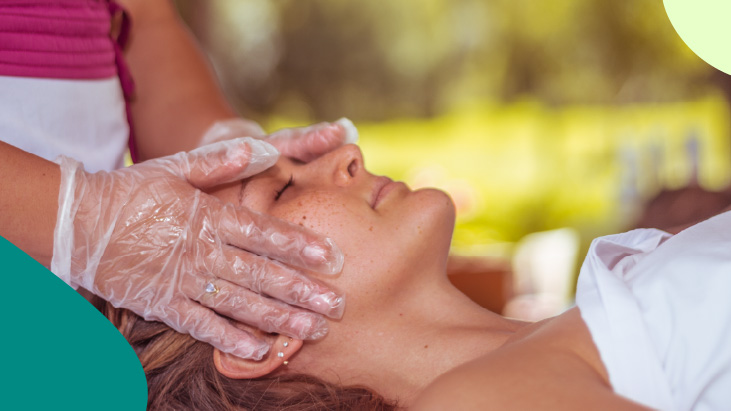
Relaxation
Aromatherapy
Essential oils are widely used, not only in medical science, as antiseptics and for their therapeutic effects. Scents have been shown to influence the limbic system, that is those parts of the brain concerned especially with emotion and motivation, and for this reason can be useful in treating mental complaints. The primary aim of aromatherapy is to cleanse and stimulate new life in both body and soul. Therapy forms include inhalation, bathing in essential oils and massaging oils into the skin.
Autogenics training
Autogenics training was developed in the early 20th century by the German physician Johannes Schultz (1884–1970). The method is based on autosuggestion. By carrying out simple exercises in either a seated or lying position and by concentrating on certain formulas or parts of the body it is possible to attain a meditative state of mind. To facilitate mental control of biological and physiological functions the patient is taught to repeat simple, formulaic mantras (“My left leg is warm and heavy…”). Autogenics training is primarily recommended for the treatment of nervous dysfunctions, inability to concentrate and sleep disorders. Long-term results are only possible where the practice is continued on a regular basis; however, one-off training sessions can have a shortterm relaxing effect on the individual.
Feldenkrais
The therapy named after Moshé Feldenkrais (1904-1984) promotes the more conscious perception of our own bodies. It is designed to make everyday conditioned movements conscious and smooth out faults through the practice of a variety of exercises. After practising sitting, walking and standing it becomes easy to correct faults in posture and movement. Using this method it is possible to regain natural movement, which will lead to better care of the body and a healthier approach to oneʼs own body. Feldenkrais therapy is recommended for those with postural faults and respiratory dysfunctions as well as chronic pain, lower-body disorders and rheumatic complaints. Once learnt, the therapy can also be carried out by the patient at home.
Meditation
During meditation the patient submerges himself within his own body, thus freeing him from external and internal tensions. The attainment of spiritual enlightenment results in the freeing of spiritual strength. There are several ways to practice meditation, most of which call for concentration on a particular thought, word or even object. The basis of meditation was originally a spiritual search for God, and for this reason meditation has great significance in many religions.
Five Tibetan
The name “Five Tibetan” covers a range of energy programmes originally developed by five Tibetan monks. The programme comprises five physical exercises: swaying, candle, half-moon, bridge and hill. The exercises guarantee vitality, satisfaction and enjoyment of life besides harmonising the physical and mental processes. It is important to do the exercises daily, starting from a simple level and building up week by week. “Five Tibetan” can be easily learnt and integrated into everyday life.
Whirlpool
Hot water pool in which the output of the water jets can be regulated from intense massage to mildly effervescent.
Saunas and steam baths
Bio-sauna
Bio-saunas generate a very pleasant climate at 40-50° C which does not overburden the body. Essential oils are often introduced into the sauna too. Therapy can have a relaxing effect or a rejuvenating effect.
Finnish sauna
An extremely high temperature (120° C) sauna at about 10% humidity. Following the sauna the patient cools down outside in a plunge pool. This form of sauna therapy is effective in stimulating blood circulation and strengthening the immune system.
Hamam
The hamam is the oriental version of the steam bath and can be complemented with massages and the application of exotic scents. The temperature in the hamam may exceed 50° C.
Caldarium
The caldarium – hot water bathing pool or sweat chamber – was one of the chambers generally found in classical Roman baths. Tiled or marble-clad caldariums are designed so that the bather spends an average 30-40 minutes there in relatively low temperatures (40-50°C) and humidity of 70-100%; thanks to these conditions the caldarium is less draining for the body than a typical sauna. Used as part of a bathing therapy it is valuable to direct steam jets to the affected parts of the body.
Laconium
A dry sauna taken at a temperature of 55° C. After only a short time the body is heated to such a degree that intensive sweating rapidly purges toxic waste products from the body. Blood circulation is invigorated, the breakdown of toxins left over from metabolic processes is speeded up, and the bodyʼs defences are mobilised. In addition, regular sweating plays a part in helping to reduce stress. The Laconium stimulates the heart and regulates blood pressure leaving the patient feeling refreshed and fully relaxed both physically and mentally. Oneʼs own body should regulate how long to spend in the Laconium, although the following is a general recommendation: 15-20 minutes per session, two to three times a week.
Spa
The word derives from the abbreviation of the Latin ʻsanus per aquamʼ (health through water). In fact the term holds particular significance in Hungary, famed as the land of thermal and medicinal waters. Today medicinal baths, wellness centres, clinics and health hotels use the beneficial effects of water in a whole variety of ways, from the pearl bath through Kneipp treatments all the way to health-oriented spa regions. The word spa has become an international term in the area of whirlpool- and sauna baths, swimming pools, steam baths, beauty farms and wellness centres.